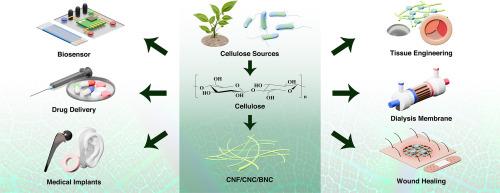Nanocellulose polymorphs for biomedical applications: Recent advances, prospects and challenges - A review
IF 6.5
Q1 CHEMISTRY, APPLIED
Carbohydrate Polymer Technologies and Applications
Pub Date : 2025-06-24
DOI:10.1016/j.carpta.2025.100916
引用次数: 0
Abstract
In the modern era, biodegradable and eco-friendly products are crucial for ensuring a sustainable future. Nanocellulose, derived from cellulose, is widely adopted for modern applications due to its versatility, sustainability, and biodegradability. Nanocellulose polymorphs, such as Cellulose Nanocrystals (CNC), Cellulose Nanofibrils (CNF), and Bacterial Nanocellulose (BNC), have found successful utilization in biomedicine due to their high strength and rigidity (CNC), toughness and flexibility (CNF), and superior biocompatibility and water retention (BNC); all while being lightweight, sustainable, and outperforming synthetic polymers, metals, and traditional cellulose in specialized applications. Nanocellulose excels in biomedicine due to its anisotropic strength, customizable porosity, and biocompatibility, which presents challenges, such as balancing surface functionalization with immunogenicity, optimizing enzymatic biodegradation kinetics, and navigating ISO-compliant manufacturing protocols for clinical-grade reproducibility. This paper encompasses literature published from 2006 to 2025, focusing on the applications of nanocellulose in the medical sector, including drug delivery systems, tissue engineering, wound healing, biosensors, medical implants, and dialysis membranes. This review also highlights the challenges of commercializing and utilizing nanocellulose in clinical settings. Some key issues include scaling up production processes, ensuring reproducibility, meeting regulatory and safety standards, assessing its environmental impact, potential cytotoxicity, and the lack of standardized protocols for characterization and testing.

纳米纤维素多晶型物在生物医学上的应用:最新进展、前景和挑战综述
在现代,可生物降解和环保产品对确保可持续发展的未来至关重要。纳米纤维素源于纤维素,由于其通用性、可持续性和可生物降解性,在现代应用中被广泛采用。纳米纤维素多晶物,如纤维素纳米晶体(CNC),纤维素纳米原纤维(CNF)和细菌纳米纤维素(BNC),由于其高强度和刚性(CNC),韧性和柔韧性(CNF),以及优越的生物相容性和保水性(BNC),在生物医学中得到了成功的应用;所有这些都是轻量级的,可持续的,并且在专业应用中优于合成聚合物,金属和传统纤维素。纳米纤维素因其各向异性强度、可定制的孔隙度和生物相容性而在生物医学领域表现优异,这也带来了一些挑战,如平衡表面功能化与免疫原性、优化酶生物降解动力学以及为临床级可重复性导航符合iso标准的制造方案。本文涵盖了2006年至2025年期间发表的文献,重点介绍了纳米纤维素在医疗领域的应用,包括药物输送系统、组织工程、伤口愈合、生物传感器、医疗植入物和透析膜。这篇综述还强调了在临床环境中商业化和利用纳米纤维素的挑战。一些关键问题包括扩大生产过程,确保可重复性,满足监管和安全标准,评估其环境影响,潜在的细胞毒性,以及缺乏标准化的表征和测试方案。
本文章由计算机程序翻译,如有差异,请以英文原文为准。
求助全文
约1分钟内获得全文
求助全文

 求助内容:
求助内容: 应助结果提醒方式:
应助结果提醒方式:


